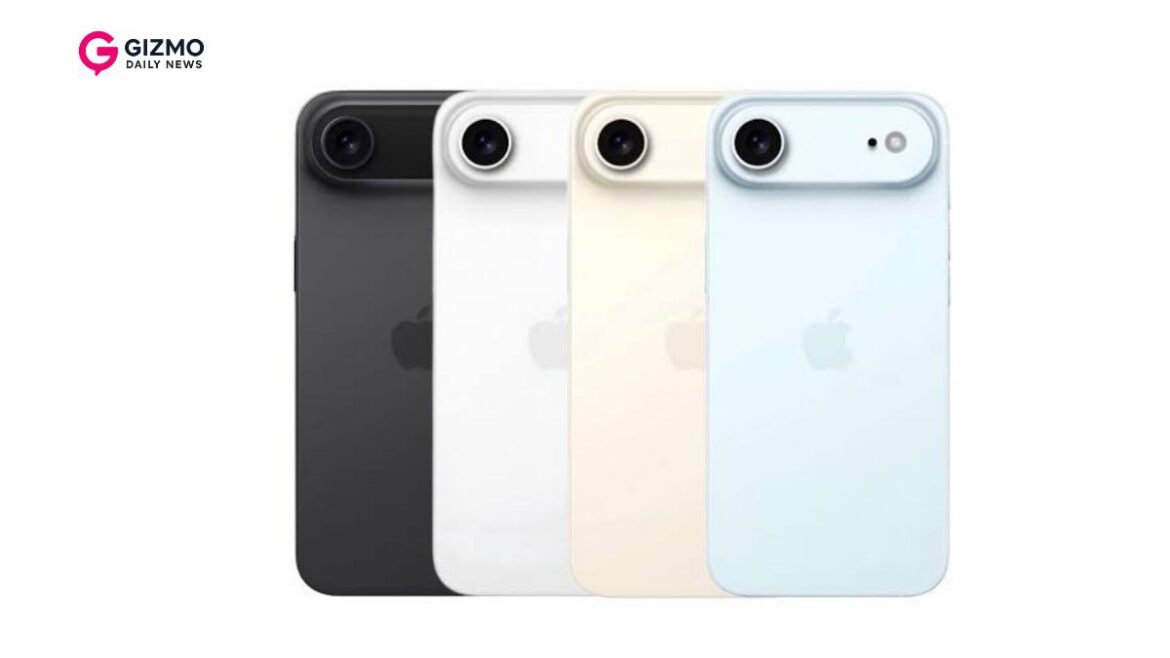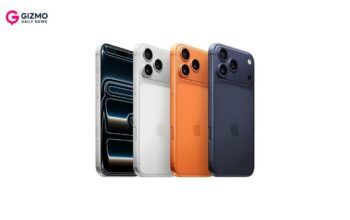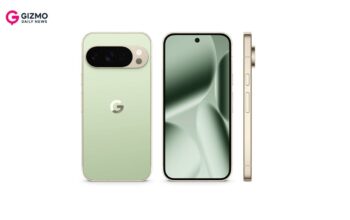The iPhone Air (2025) isn’t just another iPhone — it’s a declaration of Apple’s relentless pursuit of minimalism, performance, and sustainability. After years of refining the iPhone 15 and iPhone 16 series, Apple has now introduced something radically new: a phone that feels impossibly thin yet performs like a powerhouse.
With the iPhone Air, Apple focuses on three pillars — design, intelligence, and sustainability. Crafted from aerospace-grade titanium alloy and recycled aluminum, it weighs only 142 grams, making it the lightest iPhone ever created.
Yet inside this slim profile sits Apple’s latest A18 Bionic chip, a next-gen Neural Engine capable of handling AI-driven features, real-time computational photography, and advanced AR capabilities.
The iPhone Air (2025) is a statement piece — one that blends art, technology, and eco-conscious engineering in perfect harmony.
✨ Design & Build Quality: The Featherlight Marvel
Apple’s “Air” branding isn’t new — we’ve seen it with the MacBook Air and iPad Air. But with the iPhone Air, Apple has truly earned the name. The phone is just 6.1mm thin, with a matte titanium finish that feels premium and cool to the touch.
The flat-edge frame subtly curves toward the display, offering a more comfortable hand feel than previous generations. Apple also re-engineered the internal structure to reduce weight while maintaining rigidity — resulting in a 20% stronger chassis compared to the iPhone 16.
It’s also the first iPhone to feature a completely buttonless design. Instead, capacitive haptic sensors replace physical buttons, using Apple’s advanced Haptic Engine for precise tactile feedback.
Color options include:
- Starlight Silver
- Midnight Blue
- Rose Titanium
- Graphite Black
And yes, it’s still IP68 water and dust resistant, ensuring protection up to 6 meters for 30 minutes.
🌈 Display: OLED AirVision XDR
Apple introduces its latest AirVision XDR Display, a 6.3-inch Super Retina OLED panel with a buttery smooth ProMotion 120Hz refresh rate. The bezels are now almost invisible — only 1.2mm thick — creating a nearly all-screen experience.
Resolution comes in at 2780×1260 pixels, delivering exceptional clarity, HDR10+ support, and up to 2200 nits peak brightness, perfect for outdoor use.
Apple also added a new Adaptive Tone+ feature, which dynamically adjusts warmth and brightness based on ambient light, reducing eye strain for long use sessions.
And yes, the Dynamic Island returns — now smaller, smarter, and capable of displaying live notifications, AI suggestions, and real-time camera controls.
📸 Camera System: Slim Body, Pro-Level Optics
Despite its ultra-thin profile, Apple didn’t compromise on camera performance. The iPhone Air (2025) features a dual-camera setup that punches well above its class:
- Main Camera: 48MP f/1.6 (with quad-pixel sensor)
- Ultra-Wide Camera: 12MP f/2.2 (120° FOV)
- Front Camera: 24MP TrueDepth (AI Portrait Engine)
The new Photonic Neural Engine 3.0 processes every shot with advanced depth mapping and adaptive HDR. Low-light performance has improved drastically — photos now capture 300% more light compared to iPhone 15.
Video recording supports:
- 8K at 30fps
- 4K at 120fps (Slow Motion)
- Cinematic Mode 2.0
- Real-time AI stabilization
Apple’s new AI Video Director feature automatically composes multiple angles using the main and ultra-wide cameras — perfect for vloggers and creators.
⚙️ Performance & Hardware: The A18 Bionic Era
At the heart of iPhone Air lies Apple’s new A18 Bionic chip, built on a 3nm+ process. It delivers 20% faster CPU performance, 30% better GPU power, and 40% more efficiency compared to A17 Pro.
Specs:
- CPU: 6-core (2 performance + 4 efficiency)
- GPU: 5-core Apple-designed GPU
- RAM: 8GB LPDDR5
- Storage: 128GB / 256GB / 512GB
Benchmarks place it neck-and-neck with the M2 chip in real-world multitasking. Gaming on the Air is stunning — thanks to MetalFX rendering and advanced heat dissipation layers that prevent throttling even under heavy loads.
🧠 Intelligent Features: AI-Powered Everything
2025 marks Apple’s biggest leap into on-device AI. iPhone Air comes loaded with Apple Intelligence OS (AIOS) features:
- Smart Summary: AI condenses long texts, messages, and emails into digestible notes.
- Photo Assistant: Suggests edits, removes unwanted objects, and enhances colors.
- Voice Composer: Converts your speech into formatted text or creative writing.
- Live Translate 2.0: Real-time translation for both text and voice, even offline.
- Personal Context AI: Suggests actions based on your habits (like opening Spotify when you plug in AirPods).
All AI processing happens locally on the device, ensuring privacy and speed — no data leaves your phone.
🔋 Battery Life & Charging: Power Meets Efficiency
The iPhone Air packs a 3,200mAh battery, which might sound small, but Apple’s efficiency magic makes it last all day.
With A18’s low-power cores and OLED AirVision tech, you get:
- Up to 18 hours video playback
- Up to 16 hours web use
- 30W fast charging (USB-C)
- 15W MagSafe 3.0 wireless charging
It also supports Reverse Wireless Charging, letting you power AirPods or an Apple Watch on the back of your iPhone Air.
📡 Connectivity & Controller: The Wireless Future
The iPhone Air (2025) ships with:
- Wi-Fi 7
- 5G Ultra-Wave (mmWave + Sub-6GHz)
- Bluetooth 6.0
- UWB 2.0 Chip
- Satellite Connectivity (Text + SOS + Location Sharing)
For the first time, Apple introduces AirShare — a new high-speed file transfer system 5x faster than AirDrop.
The controller experience with Apple Vision Pro and other Apple devices is seamless, creating an interconnected ecosystem that feels futuristic.
🧭 Portability & Ease of Use
Weighing only 142g, the iPhone Air is incredibly comfortable for single-handed use. Despite being lighter than most Android flagships, it feels strong and balanced. The matte titanium coating also resists fingerprints and scratches.
Apple’s updated iOS 19 makes everything intuitive — with improved widgets, dynamic lock screens, and AI shortcuts that simplify daily tasks.
💵 Price & Variants
The iPhone Air (2025) comes in three storage options:
- 128GB – $899
- 256GB – $999
- 512GB – $1,149
It’s positioned between the iPhone 16 and iPhone 16 Pro — giving users pro-grade performance in a lighter, more affordable package.
✅ Pros
- Ultra-thin and lightweight premium build
- Brilliant OLED AirVision XDR display
- A18 Bionic with top-tier performance
- Excellent camera quality and AI photo tools
- Long battery life despite slim design
- Fast wired and wireless charging
- Enhanced AI and on-device intelligence
- Seamless Apple ecosystem connectivity
❌ Cons
- No telephoto lens
- Slight heating under heavy gaming
- Non-expandable storage
- Expensive compared to Android rivals
🏁 Final Verdict
The iPhone Air (2025) redefines what a smartphone can be. It’s a showcase of Apple’s design philosophy — sleek, smart, and sustainable. Whether you’re a creative professional, a student, or an everyday user, the iPhone Air delivers everything you’d expect from a flagship — but in a thinner, lighter, and more elegant form.
This isn’t just the thinnest iPhone — it’s the smartest Air yet.
📊 Summary Table
| Specification | Details |
|---|---|
| Display | 6.3” AirVision OLED XDR, 120Hz |
| Processor | A18 Bionic (3nm+) |
| RAM | 8GB |
| Storage | 128GB / 256GB / 512GB |
| Main Camera | 48MP f/1.6 |
| Ultra-Wide | 12MP f/2.2 |
| Front Camera | 24MP TrueDepth |
| Battery | 3200mAh, 30W fast charging |
| OS | iOS 19 |
| Connectivity | 5G, Wi-Fi 7, BT 6.0, UWB 2.0, Satellite |
| Weight | 142g |
| Colors | Starlight, Midnight, Rose Titanium, Graphite |
| Price (Base) | $899 |
🌟 Conclusion
Apple has always balanced innovation with design — and the iPhone Air (2025) is the purest expression of that philosophy. With its ultra-slim body, pro-grade performance, and intelligent features, it’s more than just an iPhone — it’s the future of mobile design.
For users who demand elegance without compromise, the iPhone Air (2025) is the ultimate statement piece in Apple’s lineup.



